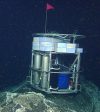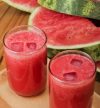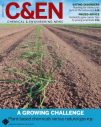ACS News Service Weekly PressPac: August 14, 2013
ACS News Service Weekly PressPac: August 14, 2013
- Science Inquiries: Michael Woods, Editor, 202-872-6293
- General Inquiries: Michael Bernstein, 202-872-6042
News Items in This Edition
Successful deployment of an autonomous deep-sea explorer to search for new forms of microbial life
Scientists are reporting “a significant step forward” in proving the feasibility of launching fleets of autonomous robots that search Earth’s deep oceans for exotic new life forms. Their description of successful deployment of the trailblazer for such a project — an autonomous seafloor lander equipped with a mini-laboratory the size of a kitchen....
Better way of checking authenticity of Earth’s smallest, most valuable bits of paper
With stamp collecting a popular hobby and lucrative investment, scientists are describing a comprehensive new way of verifying the authenticity and rooting out fakes of what may be the smallest and most valuable pieces of paper on Earth. Their report appears in the...
Watermelon juice relieves post-exercise muscle soreness
Watermelon juice’s reputation among athletes is getting scientific support in a new study, which found that juice from the summer favorite fruit can relieve post-exercise muscle soreness. The report in ACS’ Journal of Agricultural and Food Chemistry attributes watermelon’s effects to the amino acid L-citrulline...
Cigarette smoke impacts genes linked to health of heart and lungs
New insights into why obese cigarette smokers experience a high risk of heart disease suggest that cigarette smoke affects the activity of hundreds of key genes that both protect the heart and lungs and expose them to damage. The study, published in ACS’ Chemical Research in Toxicology, suggests that the...
A new sense of urgency for energy cane and other energy crops
“Energy cane” may sound like a trendy sports drink, but it actually is among a new generation of energy crops that could yield up to 5 times more ethanol per acre than corn. They are the topic of the cover story in this week’s Chemical & Engineering News. C&EN is the...
Journalists’ Resources
About the Weekly PressPac
The ACS Weekly PressPac consists of summaries of research published in the American Chemical Society’s more than 40 peer-reviewed journals and its weekly newsmagazine, Chemical & Engineering News. ACS journals publish more than 35,000 articles annually. Although not traditional press releases, PressPac content can be used to prepare news stories and also can be an excellent resource for features and background.
Press releases, briefings, and more from ACS’ 245th National Meeting
www.eurekalert.org/acsmeet.php
http://www.ustream.tv/channel/acslive
C&EN Video Spotlight: Stirring (Small) Things Up
Mixing tiny droplets of liquid can pose a big challenge to scientists. Now, thanks to a team in Singapore, researchers can reach for the world's smallest magnetic stir bars when they want to mix super-small solutions. Made from nanoparticles, these stir bars are so tiny that hundreds of millions of them can be suspended in a single drop of liquid. Watch as they make a glowing liquid whirl in a single droplet. Read the story and watch the video.
Must-Read from C&EN: Reducing Formaldehyde Emissions from Particleboard
Makers of resins — binders used to glue bits of wood together — in particleboards and other composites see two ways to reduce formaldehyde emissions from those products. For the full story, contact newsroom@acs.org.
Toolkits on Global Challenges/Research Funding
Journalists covering some of the great global challenges of the 21st century and federal funding of research and development (R&D) can find videos and scores of other resources in websites that the American Chemical Society has prepared on those topics.
The toolkits address the science of global climate science, finding sustainable sources of energy, the quest for a sustainable supply of fresh water and federal R&D funding.
An additional toolkit on sustainability in the global food supply will be available later in 2013.
C&EN Science News Channels
C&EN's news channels, called SCENEs, offer a one-stop shop for coverage of a specific topic. They provide an up-to-the-minute stream of news about analytical, biological, environmental, materials, nano and organic chemistry. Check out the SCENEs' home page.
ACS Pressroom Blog
The ACS Office of Public Affairs' pressroom blog highlights research from ACS’ more than 40 peer-reviewed journals and National Meetings.
Bytesize Science Blog
Educators and kids, put on your thinking caps: The American Chemical Society has a blog for Bytesize Science, a science podcast for kids of all ages.
ACS Satellite Pressroom: Daily news blasts on Twitter
The satellite press room has become one of the most popular science news sites on Twitter. To get our news blasts and updates, create a free account at https://twitter.com/signup. Then visit http://twitter.com/ACSpressroom and click the ‘join’ button beneath the press room logo.
C&EN on Twitter
Follow @cenmag at http://twitter.com/cenmag for the latest news in chemistry and dispatches from C&EN's blog, CENtral Science, at http://centralscience.org.
ACS Press Releases
Press releases on a variety of chemistry-related topics.
ACS Videos
The American Chemical Society encourages news organizations, museums, educational organizations and other websites to embed links to these videos.
Breakthrough Science Video Series
The ACS Breakthrough Science video series is designed to expand the visibility of selected research published in ACS journals. Gaining this kind of global publicity is one potential author benefit of publishing in ACS journals. In the series, researchers explain their ground-breaking discoveries. Check out the latest episodes of Breakthrough Science.
Prized Science video series
The new season of the Prized Science video series is available. The first episode features the research of Peter Stang, Ph.D., winner of the 2013 ACS Priestley Medal. He is a professor at the University of Utah and is the editor of the Journal of the American Chemical Society. The Priestley Medal is the highest honor of the ACS, and it recognizes Stang's pioneering work developing new ways to build molecules. The ultimate goal is to treat cancer patients with drugs that kill only cancer cells and that have fewer side effects. The second episode will feature Shirley Corriher, winner of the 2013 James T. Grady-James H. Stack Award for Interpreting Chemistry for the Public. More episodes will appear later in the year. The series is available at the Prized Science website and on DVD by email request.
The Periodic Table Table Featuring Theo Gray
Some people collect stamps. Wolfram Research co-founder and author Theo Gray collects elements. Step into his office, and you'll see a silicon disc engraved with Homer Simpson, a jar of mercury, uranium shells and hundreds of other chemical artifacts. But his real DIY masterpiece is the world's first "periodic table table.” Within this masterfully constructed table-top lay samples of nearly every element known to man, minus the super-radioactive ones.
The Chemistry of the Corpse Flower’s Stink
After 6 years of anticipation, that rock star of plants — a rainforest giant known as the corpse flower for its putrid odor — has bloomed here in Washington, D.C., and is the subject of a new video by the ACS. The video focuses on the chemical cocktail responsible for the offensive odor of the flower. More formally known as titan arum or Amorphophallus titanum, the plant is on display at the U.S. Botanic Garden, on the grounds of the U.S. Capitol.
Related Links
Inside Science News Service
Visit for thoroughly enjoyable multimedia coverage of the science behind the news — a valuable resource for journalists and news media organizations everywhere.
ACS Podcasts
Bytesize Science, a podcast for young listeners
Bytesize Science is a science podcast for kids of all ages that entertains and educates, with new high-definition video podcasts and some episodes in Spanish. Subscribe to Bytesize Science using iTunes. No iTunes? No problem. Listen to the latest episodes of Bytesize Science in your web browser.
Global Challenges/Chemistry Solutions
This special series of ACS podcasts focuses on some of the 21st Century’s most daunting challenges, and how chemists and other scientists are finding solutions. Subscribe at iTunes or listen and access other resources at the ACS web site www.acs.org/GlobalChallenges.
Science Elements: ACS science news podcast
Science Elements is a podcast of PressPac contents that makes cutting-edge scientific discoveries from ACS journals available to a broader public audience. Subscribe to Science Elements using iTunes. Listen to the latest episodes of Science Elements in your web browser. Science Elements is on Facebook, — check out the latest updates and information.
SciFinder® Podcasts
Interested in healthful plant phytochemicals, nanotechnology, or green chemistry? Check out the SciFinder series of podcasts, which explore a vast array of current interest topics and new discoveries in the 21st century. The SciFinder podcasts are available in English, Chinese, Japanese, and Portuguese.
And Don’t Miss…
General Chemistry Glossary
Simple definitions and explanations of chemistry terms.
Note to Journalists and Other Viewers
This is the latest American Chemical Society (ACS) Office of Public Affairs Weekly PressPac with news from ACS’ more than 40 peer-reviewed journals and Chemical & Engineering News.
This information is intended for your personal use in news gathering and reporting and should not be distributed to others. Anyone using advance ACS Office of Public Affairs Weekly PressPac information for stocks or securities dealing may be guilty of insider trading under the federal Securities Exchange Act of 1934.
Please cite the individual journal, or the American Chemical Society, as the source of this information.
The American Chemical Society is a non-profit organization chartered by the U.S. Congress. With more than 163,000 members, ACS is the world’s largest scientific society and a global leader in providing access to chemistry-related research through its multiple databases, peer-reviewed journals and scientific conferences. Its main offices are in Washington, D.C., and Columbus, Ohio.










